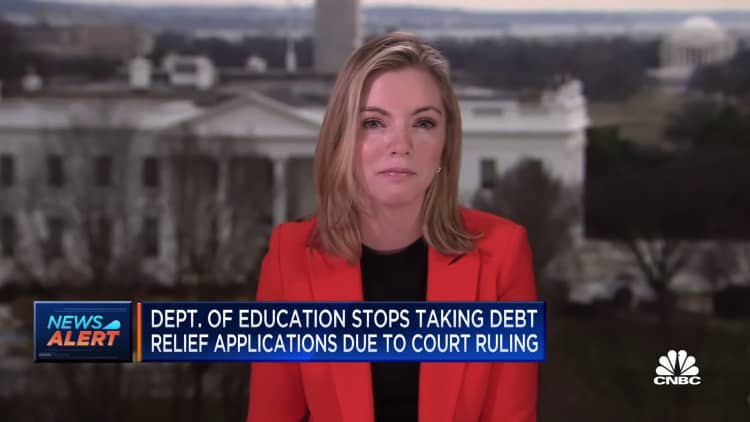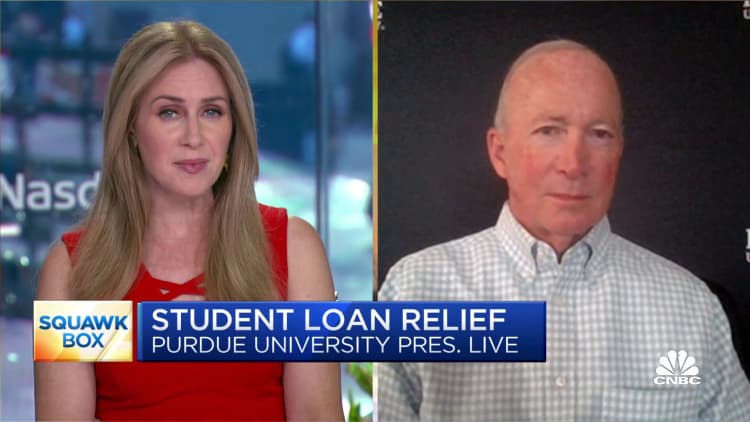While those with federal student loans wait to see if the Biden administration's sweeping loan forgiveness plan survives two Supreme Court challenges, another big change is also on the horizon for borrowers.
The U.S. Department of Education is working to create a new repayment option for the tens of millions of Americans with federal education debt.
Under the plan, in which the government predicts about a third of borrowers will enroll, monthly bills could be reduced by half.
More from Personal Finance:
64% of Americans are living paycheck to paycheck
What is a 'rolling recession' and how does it impact you?
Almost half of Americans think we're already in a recession
Here's what you need to know.
What is the new plan called?
The new option would change one of the four current income-driven repayment plans that limit borrowers' bills at a share of their discretionary income.
Instead of paying 10% of their discretionary income a month on the Revised Pay As You Earn Repayment, or REPAYE, Plan, borrowers would be required to pay just 5% toward their undergraduate student loans.
Currently, after 20 years of payments on undergraduate student loans, any leftover debt is forgiven on the existing REPAYE Plan. The revised option preserves that timeline.
However, under the Biden administration's proposal, those with original student loan balances of $12,000 or less may get their loans forgiven after just 10 years.
How would payments change?
Under the current REPAYE Plan, discretionary income is calculated as money earned over 150% of the federal poverty guideline. As a result, single borrowers begin to make payments based on income over roughly $21,900, based on 2023 guidelines, said higher education expert Mark Kantrowitz.
Under the new plan, borrowers wouldn't need to make payments based on income earned until it hit 225% of the federal poverty guideline, or about $32,800, Kantrowitz said.
He provided an example of how monthly bills could change with the overhauled option.

Previously, a borrower who made $40,000 a year would have a monthly student loan payment of around $151. Under the revised plan, their payment would drop to $30.
Someone who earned $90,000 a year, meanwhile, could see their monthly payments shrink to $238 from $568, Kantrowitz calculated.
And those who earn under around $32,800 will have $0 monthly payments.
Who qualifies?
The new option should be available to borrowers with undergraduate and graduate student loans, although undergraduate borrowers will have lower payments. Those with Parent Plus loans won't be eligible to enroll in the overhauled plan.
Defaulted loans are typically ineligible for income-driven repayment plans. Yet under the new proposal, those who have fallen behind may be able to sign up for the Income-Based Repayment, or IBR, Plan, another one of the income-driven repayment plan options.
When could the plan be available?
The new REPAYE Plan could officially be available July 1, 2024, according to Kantrowitz. But some parts of the plan could be implemented sooner, he said.
How can I sign up?
Once the new REPAYE Plan is available, borrowers can call their student loan servicer to enroll in the option, or apply at StudentAid.gov.
"Any new plan will likely take quite some time to implement, so borrowers will have plenty of time to learn about how it might work," said Scott Buchanan, executive director of the Student Loan Servicing Alliance, a trade group for federal student loan servicers.
Is the forgiven debt taxable?
It's unclear whether debt forgiven at the end of the repayment timelines will be taxable at the federal level.
Debt forgiveness used to trigger a tax bill under income-driven repayment plans. But a recent law ended that policy until at least 2025, and experts believe it could become permanent.
It's also possible that some states will consider the forgiven debt taxable.

What's going on with the payment plan pause?
The Covid pandemic-era relief policy suspending federal student loan bills and the accrual of interest has been in effect since March 2020.
For now, the Education Department is leaving things a little open-ended when it comes to the timing of payments resuming.
It has said the bills will be due again only 60 days after the litigation over its student loan forgiveness plan resolves and it's able to start wiping out the debt.
If the Biden administration is still defending its policy in the courts by the end of June, or if it's unable to move forward with forgiving student debt by then, the payments will pick up at the end of August, it has said.
The Supreme Court will start hearing arguments on legal challenges to the plan Feb. 28.


